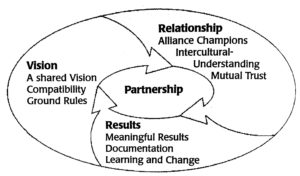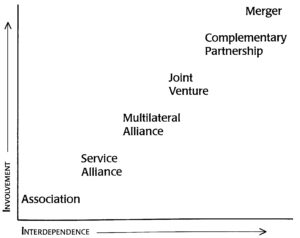In Making Your Partnership Work (2002), author Daniel Rickett has presented the “collective wisdom” that Partners International has gained over the years “in a way that others can use it” (2002, p. xiv). The short and practical book is written particularly with missionaries in mind, but more broadly for “anyone else who would say, ‘I am with you in the ministry of the gospel’” (Rickett, 2002, p. xiii). “To have productive partnerships,” write Rickett, “we must have vision, relationship, and results” (2002, p. 23). These three “Imperatives of Partnership” (see Figure 1) provide the structure of the book, which is divided into three parts with three chapters each. At the end of each part, Rickett provides a checklist, and at the end of the book three additional resources are appended. Throughout the book are dispersed several graphs, charts, and sample documents.

Figure 1: The Imperatives of Partnership (Rickett, 2002, p. 24)
One of the most helpful concepts for me in my current thinking regarding partnerships was the “Alliance Continuum” chart. Levels of partnership can be indicated depending on the measure of interdependence and involvement (see Figure 2). Considering our church’s CityPartners’ network of relationships, this concept helps to differentiate the level of partnership we have with the various organizations, churches, institutions, and initiatives. For example, I can categorize our contacts ranging from a network connection, to a recipient of funding, to an opportunity for volunteer participation, to a joint venture project, to a multi-partner alliance, to a strategic long-term partnership. A merger might take place if two partners merge their ministries in order not to duplicate efforts and to join strengths.

Figure 2: Alliance Continuum (Rickett, 2002, p. 21)
A second insight that helped me in my thinking is the concept of “Alliance Champions” (Rickett, 2002, p. 55). Rickett states that “each organization must have at least one person dedicated to managing the relationship” (2002, p. 55). It is important that these partners “build rapport” and spend time in “face-to-face meetings” in order to overcome the challenges of “distance, culture, and language” (Rickett, 2002, p. 56). Expectations need to be clarified up front with a commitment to “keep things simple” and “keep communications flowing” (Rickett, 2002, p. 59). Champions take time to pray together and commit to journey together through difficult times. Organizational leaders need to use wisdom in selecting qualified people and provide the necessary support for the partnership champions. “Alliance champions are the main personal link” between the partners, concludes Rickett, thus the “quality of a partnership rests on the quality of the people charged with making it work” (2002, pp. 62-63). Thinking through the partnerships that CityPartners manages, it is important for us to clearly identify: 1) who on our side connects with who on the partner’s end; 2) what the expectations, commitment, and way of communications are; and 3) how the champions are selected and supported by leadership.
Rickett’s book does not discuss the theology and philosophy of partnership, but dives right into the challenges and practical applications of making partnerships work. It does the title justice by providing examples and advise from decades of hard-earned collective experience by Partners International. I intent to implement a number of these recommendations in our CityPartners ministry, particularly by creating a categories of partner relations and assigning champions for each partner.
By Jacob Bloemberg
Rickett, D. (2002). Making your partnership work. Enumclaw, WA: WinePress Pub.




